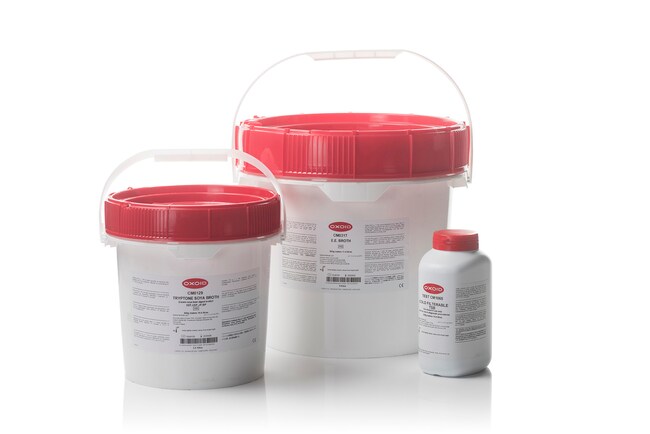Search Thermo Fisher Scientific

Tryptone Bile Agar (Dehydrated)
Detect and enumerate Escherichia coli in foods using a modified direct plating method with this medium.
Detect and enumerate Escherichia coli in foods using a modified direct plating method with Thermo Scientific™ Oxoid™ Tryptone Bile Agar (Dehydrated). The Direct Plating Method (DPM) described by Anderson and Baird-Parker is a modification of that described by Delaney et al.1. This method, developed for the detection and enumeration of Escherichia coli in water and food samples, utilizes the ability of Escherichia coli to produce indole from tryptophan at 44°C when grown on a cellulose acetate membrane on plates of Tryptone Bile Agar.
The recovery and enumeration of Escherichia coli and coliforms present in environmental or food samples are important indicators of hygiene. Tryptone Bile Agar has been developed according to the formulation of Anderson and Baird-Parker2 for the detection and enumeration of Escherichia coli in foods.
It has several advantages over older methods:
- It is faster.
- It is less variable.
- It gives better recovery from frozen samples.
- It detects anaerogenic and poor lactose-fermenting strains.
The Direct Plating Method (DPM) described by Anderson and Baird-Parker is a modification of that described by Delaney et al.2. This method, developed for the detection and enumeration of Escherichia coli in water and food samples, utilizes the ability of Escherichia coli to produce indole from tryptophan at 44°C when grown on a cellulose acetate membrane on plates of Tryptone Bile Agar.
The authors concluded that the formation of indole was a more reliable characteristic for both enterotoxigenic and non-enterotoxigenic strains of Escherichia coli than lactose fermentation. Ewing3 found that only 90% of Escherichia strains produce acid from lactose within two days, whereas 99% of strains produce indole.
The International Commission on Microbiological Specifications for Foods (CMSF)4 compared the Most Probable Number (MPN) and the Anderson-Baird-Parker Direct Plating Method (DPM) and concluded that the DPM was preferable to the MPN method of enumeration of Escherichia coli in raw meats, because of less variability, better recovery from frozen samples, greater rapidity and the smaller quantity of medium needed.
The Direct Plating Method will enumerate both anaerogenic and late lactose-fermenting strains of Escherichia coli which would be missed by the MPN method. According to Ewing3 these organisms comprise as many as 10% of Escherichia strains.
Holbrook et al.5 have further modified the Direct Plating Method for detection and enumeration of sublethally damaged cells of Escherichia coli in frozen, dried, heat processed or acid foods. In this modification the inoculum is applied to a cellulose acetate membrane on Minerals Modified Glutamate Agar and incubated for 4 hours at 37°C. The resuscitation step permits the repair of stressed cells before the transfer of the membrane to a Tryptone Bile Agar plate.
It has been shown that the presence of high levels of fermentable carbohydrates will inhibit the synthesis of tryptophanase6 and thereby stop indole formation. Holbrook et al. have demonstrated that the resuscitation step reduces the high concentration of sugar present in the inoculum to a level which does not interfere with the production of indole by Escherichia coli when grown on Tryptone Bile Agar. The resuscitation step should always be carried out when testing dairy or other products containing high concentrations of sugars.
The indole reagent described by Vracko and Sherris7 was found to be the most suitable, giving the most distinct reaction and reproducibility. The reagent, 5% p-dimethylaminobenzaldehyde in 1N hydrochloric acid is easy to prepare and will not deteriorate when kept for three months in the dark at room temperature.
All indole positive strains give well defined pink colonies when `stained’ using the indole reagent; colonies that do not produce indole are straw colored.
The growth of indole positive organisms other than Escherichia coli is inhibited by the selective action of the bile salts and the elevated incubation temperature.
The `stained’ membranes may be `fixed’ by drying in direct sunlight or under a low pressure fluorescent ultra violet lamp with a `Woods’ type filter. When dried the intensity of the staining reaction is improved, and such membranes may be stored for reference.
Not all products are available for sale in all territories. Please inquire.
Remel™ and Oxoid™ products are now part of the Thermo Scientific brand.
General References:
- Delaney J. E., McCarthy J. A. and Grasso R. J. (1962) Wat. Sewage Works. 109. 289
- Anderson J. M. and Baird-Parker A. C. (1975) J. Appl. Bact. 39. 111-117.
- Ewing W. H. (1972) COC Atlanta, US Dept. of Health, Education & Welfare.
- International Commission on Microbiological Specifications for Foods (1979) Can. J. Microbiol. 25. 1321-1327.
- Holbrook R., Anderson J. M. and Baird-Parker A. C. (1980) Food Technol. in Aust. 32. 78-83.
- Clarke P. H. and Cowen S. T. (1952) J. Gen. Microbiol. 6. 187-197.
- Vracko R. and Sherris J. C. (1963) Amer. J. Clin. Path. 39. 429-432.
- Sharpe A. N. and Jackson A. K. (1972) Appl. Microbiol. 24. 175-178.